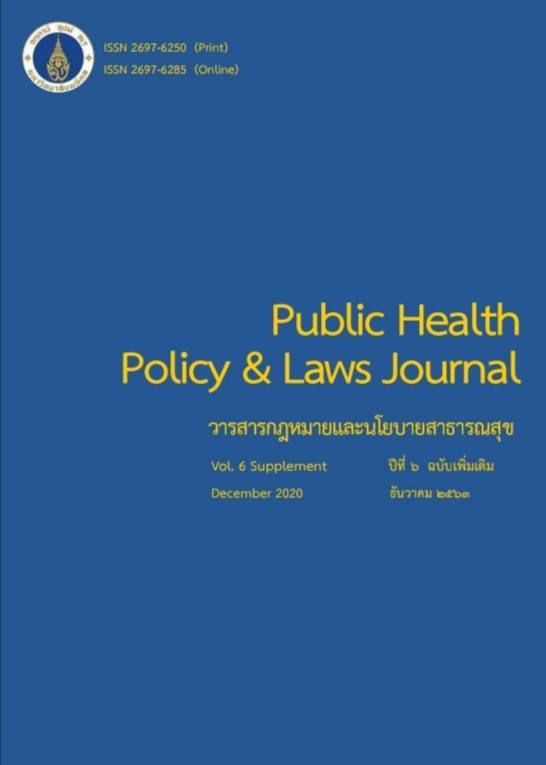The Morphine Control Measures for Health Establishments
Keywords:
Morphine control measure, Morphine control, Opioid controlAbstract
Morphine, an opioid analgesic is a derivative of opium. It is widely used within medical settings due to its painkilling ability. Nevertheless, its application is strictly restricted in order to prevent abuse of addiction, since the substance’s legal status is categorized as a narcotic drug. This article is a documentary research, with the objective to study the problems of morphine control in health establishments. Related documents, textbooks, academic journals, research papers, and other academic materials in electronic formats, both in Thai and English languages, are included for literature review. This article proposes recommendations on proper morphine control measures for health establishments.
The study found that problems of morphine control in health establishments included storage and dispensation. which could lead to smuggling or abuse. Secondly, there were problems with types and quantity of available morphine in stocks, since it was not possible to keep stocks of all types, and in too much quantity, due to restrictions. Thirdly, transferring of morphine between health establishments was prohibited, because of the substance’s legal status.
Recommendations were as followed: 1) Separation and secured storage of morphine, guarded by designated staff with record of time log, of access and dispensation; 2) Indicate clearly of authorized personnel for morphine dispensation, such as physicians, dentists, veterinarians, etc. 3) Keeping morphine at a lower quantity in stocks and procurement, in case If a health establishment was unable to store all necessary types of morphine. 4) Permission for health establishments to use patients’ medical prescriptions for narcotic-drug dispensation from other health establishments, as an alternative for morphine transfer restriction.
References
กองควบคุมวัตถุเสพติด สำนักงานคณะกรรมการอาหารและยา กระทรวงสาธารณสุข. (2556). คู่มือแนวทางปฏิบัติสำหรับบุคลากรทางการแพทย์เกี่ยวกับการมีไว้ในครอบครองหรือใช้ประโยชน์ซึ่งวัตถุออกฤทธิ์หรือการจำหน่ายยาเสพติดที่ใช้ประโยชน์ทางการแพทย์. กรุงเทพมหานคร: โรงพิมพ์สำนักงานพระพุทธศาสนาแห่งชาติ.
กองบริหารการสาธารณสุข สำนักปลัดกระทรวงสาธารณสุข กระทรวงสาธารณสุข (2561). แนวทางการบริหารจัดการระบบยาในการดูแลผู้ป่วยแบบประคับประคอง (Palliative Care) ของหน่วยงานในสังกัดสำนักงานปลัดกระทรวงสาธารณสุข. นนทบุรี: กระทรวงสาธารณสุข.
คณะกรรมการเภสัชกรรมและการบำบัดโรงพยาบาลศิริราช. (2560). Hight Alert Drug คู่มือการใช้ยาที่มีความเสี่ยงสูง. พิมพ์ครั้งที่ 4. กรุงเทพมหานคร: โรงพยาบาลศิริราช.
“ประกาศกระทรวงสาธารณสุขเรื่องกำหนดหลักเกณฑ์และวิธีการในการกำหนดปริมาณยาเสพติดให้โทษในประเภท 2 ที่ผู้อนุญาตจะอนุญาตให้จำหน่ายหรือมีไว้ในครอบครอง (ฉบับที่ 3) พ.ศ. 2558,” ราชกิจจานุเบกษา เล่มที่ 132 ตอนพิเศษ 193 ง (21 สิงหาคม 2558), หน้า 6. และบัญชีท้ายประกาศกระทรวงสาธารณสุข เรื่อง กำหนดหลักเกณฑ์และวิธีการในการกำหนดปริมาณยาเสพติดให้โทษในประเภท 2 ที่ผู้อนุญาตจะอนุญาตให้จำหน่ายหรือมีไว้ในครอบครอง (ฉบับที่ 3) พ.ศ. 2558.
“ประกาศคณะกรรมการพัฒนาระบบยาแห่งชาติ เรื่องบัญชียาหลักแห่งชาติ พ.ศ. 2562,” ราชกิจจานุเบกษา. เล่มที่ 136 ตอนพิเศษที่ 95 ง (17 เมษายน 2562), หน้า 8. และภาคผนวก 1 รายการยาในบัญชียาสำหรับโรงพยาบาลและสถานบริการสาธารณสุขตามบัญชียาหลักแห่งชาติ พ.ศ. 2562 ลงวันที่ 19 มีนาคม 2562.
“พระราชบัญญัติยาเสพติดให้โทษ พ.ศ. 2522,” ราชกิจจานุเบกษา เล่มที่ 96 ตอนที่ 63 (22 เมษายน 2522), หน้า 40-49.
สำนักพัฒนาวิชาการแพทย์ กรมการแพทย์ กระทรวงสาธารณสุข. (2547). แนวทางเวชปฏิบัติการดูแลรักษาความปวดจากมะเร็ง. กรุงเทพมหานคร: สำนักพิมพ์ชุมนุมสหกรณ์การเกษตรแห่งประเทศไทย.
U.S. FDA. (2011). Highlights of prescribing information. Retrieved February 10, 2020. from https://www.accessdata.fda.gov/drugsatfda_docs/label/2011/202515s000lbl.pdf.
World Health Organization. (1986). Cancer pain relief. Switzerland: World Health Organization.
World Health Organization. (2018). Management of substance abuse. Retrieved February 9, 2020. from https://www.who.int/substance_abuse/information-sheet/en/.
Downloads
Published
How to Cite
Issue
Section
License
Disclaimer and Copyright Notice
The content and information presented in articles published in the Journal of Law and Public Health Policy represent the opinions and sole responsibility of the respective authors. The editorial board does not necessarily agree with or assume any responsibility for the views expressed.
All articles, data, content, images, and other materials published in the Journal of Law and Public Health Policy are the intellectual property of the journal. Any individual or organization wishing to reproduce, distribute, or otherwise use the entirety or any part of such materials must provide proper citation.





